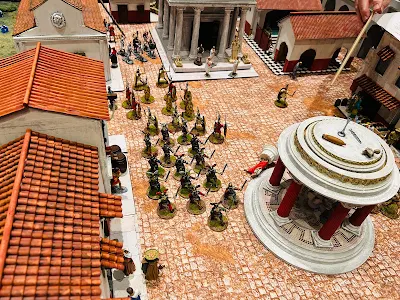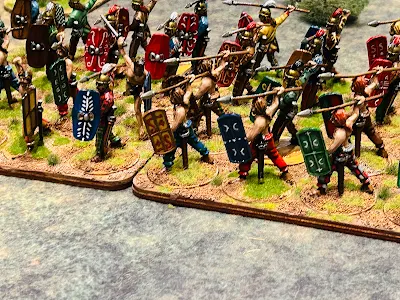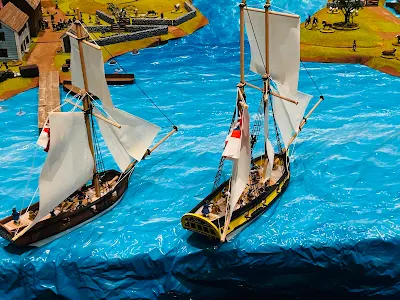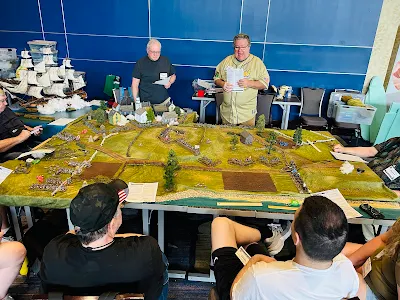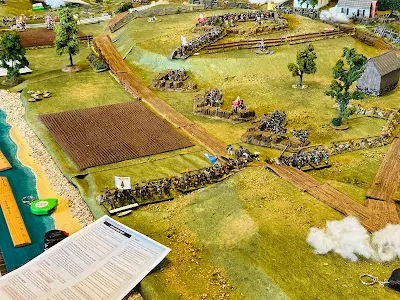Friday, July 25, 2025
Romans, Come Out To Play-Yay!!!!!
Wednesday, July 23, 2025
Hannibal! The War Game
I took part in Jim's massive 54mm battle between Republican Romans and Hannibal's army. Spread out over two sets of tables it was a massive affair and a feast for the eyes. The terrain was magnificent and included a Roman town. The figures were outstanding and beautifully painted. Simple rules which kept the game moving quickly. What more could you ask for!
The game is set up on two very long tables with a gap between them. This facilitate the movement of players and being able to move the large commands.
On one end of the table is a beautiful Roman city. There are lots of buildings, and many civilians going about there business.
On the other end is a magnificent Roman camp. All built by Jim.
The Republican Roman army is mostly heavy type infantry with a small cavalry force guarding the left flank.
The Carthiginians of course are much more diverse. You get heavy infantry, light infantry slingers, Celtics, lots of cavalry of all types and of course elephants!
And so the two armies line up and march forward....
On the Roman left, a massive cavalry battle. Although out numbered the Romans held there own. It went back and forth for the game. But in the end the Romans (barley) held on.
In the center elephants attacked but were destroyed by Roman spears.
I was on the right of the Roman line., with three legions. Opposite me I could make out light Cavalry, Celtics and infantry with spears. And they we're all marching g towards me!
The Celtics had an interesting attack. On the first charge they got a +2 for their fury. After that they were regular no modifiers.
Here they come! Steady boys and hold on to your spears!
We managed to see off the light Cavalry. That was more to my good dice rolling and Kevin's poor dice rolling. But at least my line was not turned. Then it was a slug feast with both sides losing figures. Pretty bloody battle. In the end my morale just held while their morale didn't and off they went.
About this time Jim called the game. It was bloody and both sides had lost a lot of troops but the Roman line held; just. Jim called it a tie and I would go with that since I am not sure many of our commands would have passed any more morale tests.
None of us realised over three hours had passed! The rules were simple and got the job done in an efficient manner. By the second turn we understood them and could concentrate on playing and not figuring things out. Just what you want for a convention or game night. Actually in my old age just what I want in any game!
Thank you Jim for an great game. Its fun playing with 54mm figures and you really put a lot into thus game. Thank you to Steve and Kevin who I played against. They both were excellent players, very funny great Players and just the people you want in a game. All in all an outstanding game and excellent day.
Monday, July 21, 2025
Historicon 2025
Just got back home from the convention. I had planned to post after each day but my Kindle Fire gave up the ghost and stopped working. So now that its fixed I will give a recap of the events and a separate post on the two big games I played in.
Not sure about the game but a zeppelin is always going to grab your attention. I think it was some science fiction game in a alternative universe. No matter the airship is pretty cool.
American Revolution game, the Battle of Guilford Courthouse with 15mm Wofun miniatures. Simple but very nice looking game. These look like great travel type figures when on the go and you don't want to lug around the painted lead. I like these very much.
Wings of War air plane game. Fighting over the skies of France.
The War of the Worlds Martian invasion. Based on the books by Scott Washington the Martians invade the world again.
Attack on Roman fortifications. Really nice looking game with excellent terrain.
Old School style Napoleonic game. This was great! Reminded me of when I got started with miniature games in the 1970's. Simple terrain and basic painted figures. Big beefy battalions that look the part. Not sure of the figures, might be minifigs.
Ice Station Zebra? Very clever terrain for fighting in the Arctic. Great looking submarine popping up through the ice.






